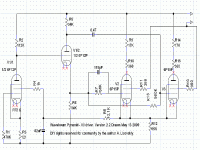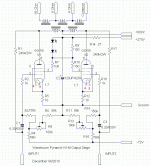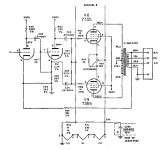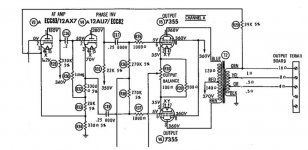I am trying to re-design an amp which had 4x6550 in each push pull output stage (ultra linear) but used a modern op-amp (OPA453) to generate the differential drive signal.
I was looking at triode long tailed pair but cannot get quite enough drive level, and open loop gain for the NF to go back to the grid. Also the miller effect was affecting the stability of the NF.
I saw a post on pentodes, could I use say a couple of 6CB6 as a long tailed pair with a constant current tail. Whats the best way to balance - could I alter the screen grid voltages until the outputs are the exact opposite or a pot in the cathodes?
I was looking at triode long tailed pair but cannot get quite enough drive level, and open loop gain for the NF to go back to the grid. Also the miller effect was affecting the stability of the NF.
I saw a post on pentodes, could I use say a couple of 6CB6 as a long tailed pair with a constant current tail. Whats the best way to balance - could I alter the screen grid voltages until the outputs are the exact opposite or a pot in the cathodes?
Pentodes should work fine as long as they can handle the drive voltage range needed and gain to get there. Screen grid V adjustments or grid 1 bias adjustments for DC balance, cathode resistors or plate resistors adjustable for AC balance (not needed with a CCS tail and precision resistors).
Take a look at Pete Millett's 50 Watt Monoblock schematic:
http://www.pmillett.com/file_downloads/dcpp_mb_sch.pdf
The earlier Engineer's Amp version used 6CB6 drivers, then the later 50 Watt version went to 6GU5 for more gain. These however are remote cutoff tubes. More linear alternatives for more gm are 8136, 6EW6 and 5JK6 (pin compatible). In 9 pin there are many choices like EF184/6EJ7 or 6JC6 ( $1 list). 12 pin duals: 6BN11, 6J11, 8CB11. (all $1 list also)
Take a look at Pete Millett's 50 Watt Monoblock schematic:
http://www.pmillett.com/file_downloads/dcpp_mb_sch.pdf
The earlier Engineer's Amp version used 6CB6 drivers, then the later 50 Watt version went to 6GU5 for more gain. These however are remote cutoff tubes. More linear alternatives for more gm are 8136, 6EW6 and 5JK6 (pin compatible). In 9 pin there are many choices like EF184/6EJ7 or 6JC6 ( $1 list). 12 pin duals: 6BN11, 6J11, 8CB11. (all $1 list also)
Last edited:
Well, they can be if you use the remedies you suggested.The duals are not matched however.
A CCS tail will AC match.
DC match with either grid 2 or grid 1 bias adjusts.
Someone (I forget who) used an ECF80 as an LTP phase splitter. Pentode first stage (to eliminate Miller effect), triode second stage. It worked reasonably well without a CCS tail; with a good tail it would be even better.
Wow the EF184/6EJ7 has twice as much gain as the 6CB6 and come in standard 9-pin with a max plate of 2.5W. Think the balancing pot in the cathodes works best for me maybe 100 or 220R but it does pass the DC current. Plenty of open loop gain for the NF and very good distortion figures on LT spice.
Radford?
Found this:
New Phase Splitter
Unfortunately some of the current goes up the screen grid so the anode resistors need adjusting - but its one valve rather than two or one 12 pin.
Last edited:
Pay special attention to the screen power source, because this is a very important point to make the pentode differential amp to give us the best of it.
The Bailey-Radford pentode-triode phase splitter is anticipated by a year or two in the RCA High Fidelity Amplifier Circuits book of 1959.
I need to stick to the dual pentode approach as I have the input signal on one side and the NFB on the other. Both would be affected by the miller effect as in the Pete Millett's 50 Watt Monoblock schematic.
Q. Is it better to
1) connect the screens together via 1k resistors and feed then from the same voltage from a decoupled potential divider as he does.
or
2) Run them separately from a decoupled dropper resistors just from HT.
The screen current is what not does not get to the plate and so affects both AC and DC balance. With 2 the current is more likely to be similar (I think) if the vales are not perfectly matched. Am I correct or is 1 better?
Q. Is it better to
1) connect the screens together via 1k resistors and feed then from the same voltage from a decoupled potential divider as he does.
or
2) Run them separately from a decoupled dropper resistors just from HT.
The screen current is what not does not get to the plate and so affects both AC and DC balance. With 2 the current is more likely to be similar (I think) if the vales are not perfectly matched. Am I correct or is 1 better?
The Bailey-Radford pentode-triode phase splitter is anticipated by a year or two in the RCA High Fidelity Amplifier Circuits book of 1959.
http://www.tubebooks.org/file_downloads/RCA_HiFi.pdf
I don't see the Bailey-Radford splitter in there. RCA has their new 7199 being used as a pentode front end followed by a Concertina splitter.
I need to stick to the dual pentode approach as I have the input signal on one side and the NFB on the other. Both would be affected by the miller effect as in the Pete Millett's 50 Watt Monoblock schematic.
The Global N Fdbk R network can be low impedance at the splitter.
For a differential stage, the common'd screen grid source likely works fine. More constant V from an RC filter.Q. Is it better to
Quite true the global NF can be very low impedance and the first stage I have a MOSFET buffer so the miller effect is not such an issue. The pentode solution has better AC balance as both halves have screen grid currents but need two devices or one 12 pin.
The main advantage for me is that it gives high VAS gain, I was trying to avoid the NF back to the first stage as it introduces yet more phase shift. So the first stage is a 1/2 12AU7 and MOSFET follower with bootstrap to the first stage plate load. The bootstrap improves the 2nd harmonic distortion.
The main advantage for me is that it gives high VAS gain, I was trying to avoid the NF back to the first stage as it introduces yet more phase shift. So the first stage is a 1/2 12AU7 and MOSFET follower with bootstrap to the first stage plate load. The bootstrap improves the 2nd harmonic distortion.
Last edited:
I used 6P15P pentodes in my Pyramid amp. Pentode LTP driver, with local feedback to it's anodes around output GU-50 tubes.
Anatoliy, R13 (560K) sets the bias for V3 and R7 (56K) for V2. In which way does the FB path over R13 affect the working of the phase inverter?
How about using positive feedback as Harman kardon hk a500 . I think the gain of the input stage is 500 .
Would it not be NFB with a gain of around 90?
Attachments
I simulated once the AF and the phase splitter to get a gain of 500 if I do remember. The smartness of the circuit that the positive feedback that the AF receives from 330 ohms is the same point where it receives the overall negative one . Now I remember having seen a later model of HK which uses only pentodes ,maybe 12BY7 ,video output tubes for sure. I will look for it. Here is it Harman Kardon Cit. II , 6560 KT88 PP , ed vers 2 | Ampli. valv. in 2019 | Valve amplifier, Vacuum tube, Hifi audio
Last edited:
- Home
- Amplifiers
- Tubes / Valves
- Pentode long tailed pair



